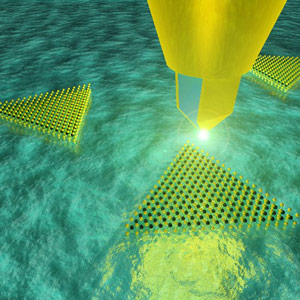
Scientists at the Molecular Foundry have used a unique nano-optical probe to study the effects of illumination on two-dimensional semiconductors at the molecular level. The team used the “Campanile” probe they developed to make some surprising discoveries about molybdenum disulfide, a member of a family of semiconductors, called “transition metal dichalcogenides (TMDCs), whose optoelectronic properties hold great promise for future nanoelectronic and photonic devices.
The Foundry’s Campanile probe won a prestigious R&D 100 Award in 2013 for combining the advantages of scan/probe microscopy and optical spectroscopy. The probe features a tapered, four-sided microscopic tip that is mounted on the end of an optical fiber and resembles the landmark “Campanile” clock tower on the campus of the University of California at Berkeley. The tapered design enables the Campanile probe to channel light of all wavelengths down into an enhanced field at the apex of the tip. The size of the gap between the two gold layers on either side determines the resolution, which can be below the diffraction optical limit.
Taking advantage of its remarkable resolution capabilities, the team identified significant nanoscale optoelectronic heterogeneity in the interior regions of monolayer crystals of molybdenum disulfide, and an unexpected, approximately 300 nanometer wide, energetically disordered edge region. This disordered edge region, which has never been seen before, could be extremely important for any devices in which one wants to make electrical contacts and might also prove critical to photocatalytic and nonlinear optical conversion applications.

